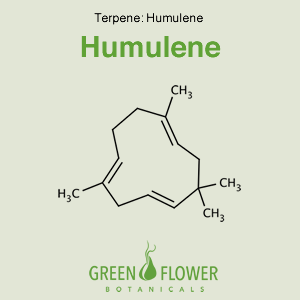Alpha-humulene is one of the most popular terpenes in the world as it’s associated with different famous aromas, like the ones of clove, basil, hops (and respectively beer), and of course, Cannabis sativa. In fact, humulene is one of the six primary cannabis terpenes, responsible not only for distinctive nuances of the flower’s smell, but also for several of its medicinal properties.
Humulene is also found in different therapeutic balsam oils.
Anti-Bacterial Effects
Humulene has demonstrated some notable anti-bacterial properties, especially against the S.aureus bacteria when used in small quantities. [1]
Anti-Cancer Effects
A study from 2003 determined that humulene has strong anti-cancer properties, finding it to be the root of balsam fir oil’s anti-tumor applications and effects. [2]
“Balsam fir oil and alpha-humulene induced a dose- and time-dependent decrease in cellular GSH content and an increase in ROS production. These results suggest that GSH depletion and ROS production may be implicated in the cytotoxicity of alpha-humulene and balsam fir oil,” the authors concluded.
Anti-Inflammatory Effects
Humulene’s anti-inflammatory effects are perhaps its most wide-spread and examined aspect.
A study from 2009 found humulene to have both preventative and therapeutic anti-inflammatory properties in a murine model of airways allergic inflammation, “an effect that seemed to be mediated via reduction of inflammatory mediators, adhesion molecule expression, and transcription factors activation,” as the authors explained. [3]
Furthermore, two years earlier, another study explored how humulene, especially in collaboration with (-)-trans-caryophyllene, seriously mitigates the release of different compounds and their chemical interactions which trigger and fuel inflammation.The study goes as far as comparing humulene’s anti-inflammatory effects to the ones of the steroidaldrug dexamethasone. [4]
Pharmacokinetic Properties
Another study delved into humulene’s pharmacokinetics properties in search of an explanation as to why the terpene is so effective when used in essential oils. [5]
“Alpha-humulene exhibited a rapid onset and relatively good absorption following oral and topical administration. Taken together, these findings further contribute to an explanation of the topical and systemic anti-inflammatory and antinociceptive properties previously reported for the essential oil and for alpha-humulene obtained from Cordia verbenacea,” the study authors conclude.
It’s also worth mentioning that humulene is paradoxically famous for being an appetite suppressant.
As you can see, humulene is pivotal to cannabis on multiple levels, spanning from pleasant and distinctive aromas to sweeping medicinal properties.
References:
- Pichette A et al, Composition and antibacterial activity of Abies balsamea essential oil, Phytother Res.2006 May;20(5):371-3.
- Legault J et al, Antitumor activity of balsam fir oil: production of reactive oxygen species induced by alpha-humulene as possible mechanism of action, Planta Med.2003 May;69(5):402-7.
- Rogerio et al, Preventive and therapeutic anti-inflammatory properties of the sesquiterpene α-humulene in experimental airways allergic inflammation, Br J Pharmacol. 2009 Oct; 158(4): 1074–1087.
- Fernandes ES et al, Anti-inflammatory effects of compounds alpha-humulene and (-)-trans-caryophyllene isolated from the essential oil of Cordia verbenacea, Eur J Pharmacol.2007 Aug 27;569(3):228-36
- Chaves JS, Pharmacokinetics and tissue distribution of the sesquiterpene alpha-humulene in mice, Planta Med.2008 Nov;74(14):1678-83








